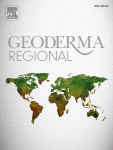Ver ítem
- xmlui.general.dspace_homeCentros Regionales y EEAsCentro Regional Buenos Aires SurEEA BordenaveArtículos científicosxmlui.ArtifactBrowser.ItemViewer.trail
- Inicio
- Centros Regionales y EEAs
- Centro Regional Buenos Aires Sur
- EEA Bordenave
- Artículos científicos
- Ver ítem
Soil physical properties under different cattle stocking rates on Mollisols in the Buenos Aires Province, Argentina
Resumen
This study evaluated the impact of different cattle stocking rates on different soil physical properties in different soils in an integrated livestock no-till agricultural system. We evaluated three stocking rates (0 animal unit ha−1, moderate: 160 animal unit ha−1, and heavy: 320 animal unit ha−1) on three soil textures (loamy sand, sandy loam and sandy clay). We also evaluated sorghum's performance after the cattle trampling in a crop sequence including
[ver mas...]
This study evaluated the impact of different cattle stocking rates on different soil physical properties in different soils in an integrated livestock no-till agricultural system. We evaluated three stocking rates (0 animal unit ha−1, moderate: 160 animal unit ha−1, and heavy: 320 animal unit ha−1) on three soil textures (loamy sand, sandy loam and sandy clay). We also evaluated sorghum's performance after the cattle trampling in a crop sequence including winter rye + hairy vetch/sorghum. The representative soil in the area is a fine-loamy, mixed and thermic Entic Haplustoll with variable clay + silt (30 to 40 g kg−1 soil). Only bulk density showed interaction between texture and stocking rate factors. The control and moderate stocking rates showed lower bulk density (1.35 Mg m−3) than the heavy grazed treatment (1.43 Mg m−3) in the loamy sand soil. No differences between moderate and heavy treatments were found in other soil indicators. Layers of 0–5 and 5–10 cm proved to offer a higher mechanical resistance that the control (39% and 30%, respectively). Hydraulic conductivity and macroporosity (>100 μm) showed a reduction close to 20% in both indicators due to cattle trampling. Sorghum crop showed no differences in plant rate emergence, biomass and grain yield. Results of this investigation indicate that grazing and animal trampling produced no significant effect on the variation of physical properties over the different soil texture, neither any impact on the emergence and development of sorghum.
[Cerrar]

Fuente
Geoderma Regional 14 : e00177 (September 2018)
Fecha
2018-09
ISSN
2352-0094
Formato
pdf
Tipo de documento
artículo
Palabras Claves
Derechos de acceso
Restringido
 Excepto donde se diga explicitamente, este item se publica bajo la siguiente descripción: Creative Commons Attribution-NonCommercial-ShareAlike 2.5 Unported (CC BY-NC-SA 2.5)
Excepto donde se diga explicitamente, este item se publica bajo la siguiente descripción: Creative Commons Attribution-NonCommercial-ShareAlike 2.5 Unported (CC BY-NC-SA 2.5)

